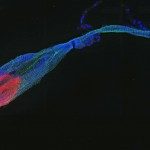Link to Pubmed [PMID] – 7548037
Biochemistry 1995 Oct;34(39):12820-9
A 21-residue peptide, P1AQFD5ADELR10AAMKG15LGTDE20D, corresponding to the (helix A)-loop motif of the second repeat of human annexin I, was synthesized and studied by 2D proton NMR. The conformational properties of the peptide were characterized at different temperatures in pure aqueous solution and in a TFE/H2O (1:4 v/v) mixture. In pure aqueous solution, the peptide adopts a preferred conformation, comprising both elements of native and nonnative structures. A high alpha helix content is present in the DADELRA segment, which corresponds to an initiation site in the middle of the native alpha helix sequence. At the N-terminus flanking region, a particular nonnative folding is revealed by the J(NH-CH alpha) coupling constants and a set of unusual NOE connectivities which correspond to a helix interrupt at the first D residue. Addition of relatively small amount of TFE restores the native helix fold at the C-terminus but not at the N-terminus. On the contrary, the nonnative N-terminus structure is clearly stabilized by TFE. Our data indicate that this structure comprises (i) an Asp5-x-x-Glu8 N-terminal capping box, as recently named by Harper and Rose [Harper, E. T., & Rose, G. D. (1993) Biochemistry 32, 7605-7609], (ii) a (i,i + 3) Asp7-x-x-Arg10 salt bridge, and (iii) a hydrophobic cluster centered on Phe4 which mainly interacts with Leu9 but also with Ala2, Ala6, and Ala12 in a dynamic way. This structure is rather stable since it is still observed at 293 K in aqueous solution and 313 K in the presence of TFE. It constitutes a very potent initiation site of the alpha helix structure. This is, however, a nonnative structure involving highly conserved residues in the whole annexin family and thus may play an important role in the folding pathway as a transient “compacting helper”.

